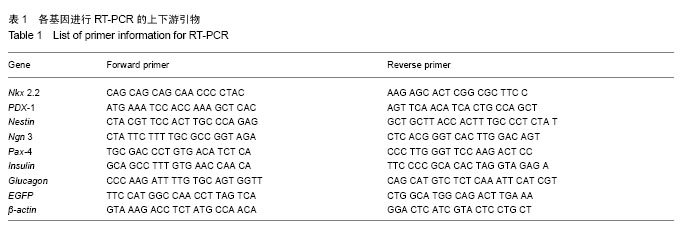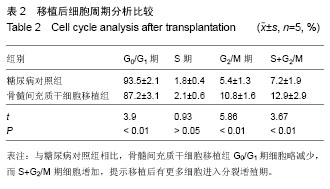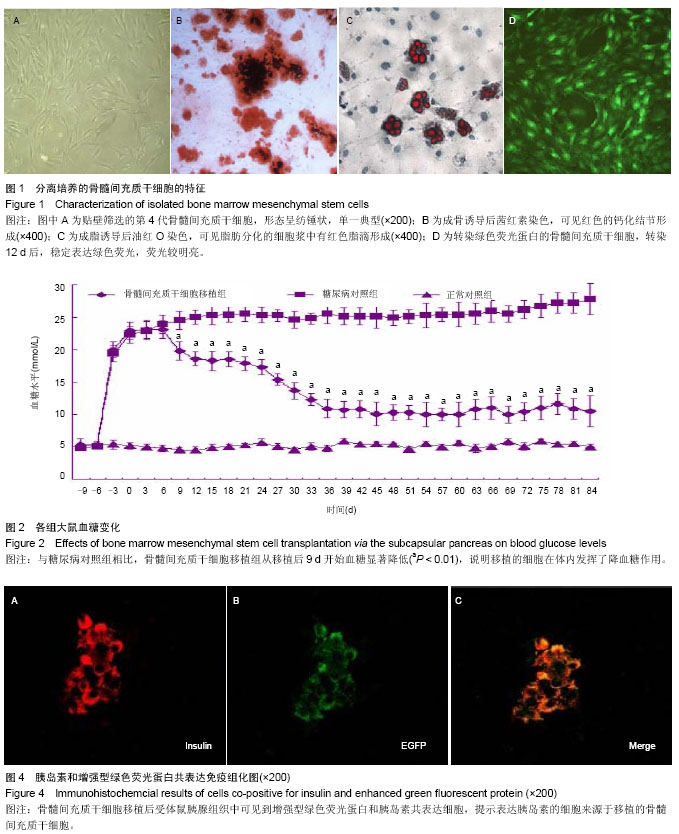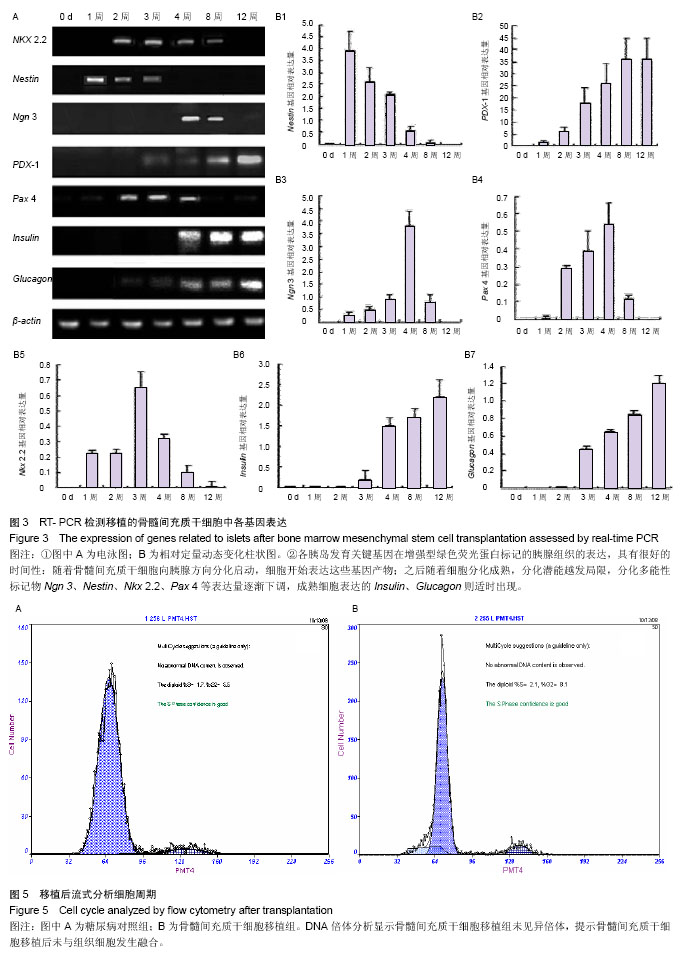| [1] Soria B, Skoudy A, Martín F.From stem cells to beta cells: new strategies in cell therapy of diabetes mellitus. Diabetologia. 2001;44(4):407-415.
[2] Shapiro AM, Lakey JR, Ryan EA, et al. Islet transplantation in seven patients with type 1 diabetes mellitus using a glucocorticoid-free immunosuppressive regimen.N Engl J Med. 2000;343(4):230-238.
[3] Wen Y, Chen B, Ildstad ST.Stem cell-based strategies for the treatment of type 1 diabetes mellitus.Expert Opin Biol Ther. 2011;11(1):41-53.
[4] Ianus A, Holz GG, Theise ND,et al. In vivo derivation of glucose-competent pancreatic endocrine cells from bone marrow without evidence of cell fusion.J Clin Invest. 2003; 111(6):843-850.
[5] Neshati Z, Matin MM, Bahrami AR,et al. Differentiation of mesenchymal stem cells to insulin-producing cells and their impact on type 1 diabetic rats.J Physiol Biochem. 2010;66(2): 181-187.
[6] Tang DQ, Cao LZ, Burkhardt BR,et al. In vivo and in vitro characterization of insulin-producing cells obtained from murine bone marrow.Diabetes. 2004;53(7):1721-1732.
[7] Limbert C, Päth G, Jakob F,et al. Beta-cell replacement and regeneration: Strategies of cell-based therapy for type 1 diabetes mellitus.Diabetes Res Clin Pract. 2008;79(3): 389-99.
[8] Moore KA, Lemischka IR.Stem cells and their niches.Science. 2006;311(5769):1880-1885.
[9] Chang C, Niu D, Zhou H,et al. Mesenchymal stem cells contribute to insulin-producing cells upon microenvironmental manipulation in vitro.Transplant Proc. 2007;39(10):3363- 3368.
[10] Gabr MM, Zakaria MM, Refaie AF,et al.Insulin-producing cells from adult human bone marrow mesenchymal stem cells control streptozotocin-induced diabetes in nude mice.Cell Transplant. 2013;22(1):133-145.
[11] Choi KS, Shin JS, Lee JJ, et al. In vitro trans-differentiation of rat mesenchymal cells into insulin-producing cells by rat pancreatic extract.Biochem Biophys Res Commun. 2005; 330(4):1299-1305.
[12] Ai C, Todorov I, Slovak ML,et al. Human marrow-derived mesodermal progenitor cells generate insulin-secreting islet-like clusters in vivo.Stem Cells Dev. 2007;16(5):757- 770.
[13] 杨亚丽,高峰,齐晖,等.骨髓间充质干细胞移植入糖尿病大鼠胰腺后的分化及对血糖的影响[J].基础医学与临床,2009, 29(6): 584-588.
[14] 高峰,周汉新,齐晖,等.骨髓间充质干细胞胰腺包膜下移植与静脉移植治疗大鼠糖尿病的效果比较[J].中国组织工程研究与临床康复,2009,13(19):3675-3679.
[15] Terada N, Hamazaki T, Oka M, et al. Bone marrow cells adopt the phenotype of other cells by spontaneous cell fusion. Nature. 2002;416(6880):542-545.
[16] Ying QL, Nichols J, Evans EP,et al. Changing potency by spontaneous fusion.Nature. 2002;416(6880):545-548.
[17] Xu YX, Chen L, Wang R, et al. Mesenchymal stem cell therapy for diabetes through paracrine mechanisms.Med Hypotheses. 2008;71(3):390-393.
[18] 范子扬,白金宝,王辉,等. 骨髓间充质干细胞促进胰岛再生的作用与研究现状[J].中国组织工程研究,2013,17(1):118-123.
[19] 邓春艳,李富荣,王新根,等.小鼠骨髓间充质干细胞减轻胰岛移植物排斥反应的作用[J].中华器官移植杂志,2010,31(9):553-557.
[20] Najafi R, Sharifi AM.Deferoxamine preconditioning potentiates mesenchymal stem cell homing in vitro and in streptozotocin-diabetic rats.Expert Opin Biol Ther. 2013;13(7): 959-972.
[21] Tsai PJ, Wang HS, Lin CH,et al. Intraportal injection of insulin-producing cells generated from human bone marrow mesenchymal stem cells decreases blood glucose level in diabetic rats.Endocr Res. 2014;39(1):26-33.
[22] Hao H, Liu J, Shen J,et al. Multiple intravenous infusions of bone marrow mesenchymal stem cells reverse hyperglycemia in experimental type 2 diabetes rats.Biochem Biophys Res Commun. 2013;436(3):418-423.
[23] Chhabra P, Brayman KL.Stem cell therapy to cure type 1 diabetes: from hype to hope.Stem Cells Transl Med. 2013; 2(5):328-336.
[24] Choi JB, Uchino H, Azuma K,et al. Little evidence of transdifferentiation of bone marrow-derived cells into pancreatic beta cells.Diabetologia. 2003;46(10):1366-1374.
[25] Urbán VS, Kiss J, Kovács J,et al.Mesenchymal stem cells cooperate with bone marrow cells in therapy of diabetes.Stem Cells. 2008;26(1):244-253.
[26] 程愈,申晶,郝好杰,等.骨髓间充质干细胞移植促进糖尿病大鼠β细胞再生的机制[J]. 解放军医学院学报,2013,34(6):610-613.
[27] Heller RS, Jenny M, Collombat P,et al. Genetic determinants of pancreatic epsilon-cell development.Dev Biol. 2005; 286(1): 217-224.
[28] Watada H.Neurogenin 3 is a key transcription factor for differentiation of the endocrine pancreas.Endocr J. 2004; 51(3):255-264.
[29] Rukstalis JM, Habener JF.Neurogenin3: a master regulator of pancreatic islet differentiation and regeneration.Islets. 2009; 1(3):177-184.
[30] Oliver-Krasinski JM, Kasner MT, Yang J,et al. The diabetes gene Pdx1 regulates the transcriptional network of pancreatic endocrine progenitor cells in mice.J Clin Invest. 2009; 119(7): 1888-1898.
[31] Kordowich S, Collombat P, Mansouri A,et al. Arx and Nkx2.2 compound deficiency redirects pancreatic alpha- and beta-cell differentiation to a somatostatin/ghrelin co-expressing cell lineage.BMC Dev Biol. 2011;11:52.
[32] Zulewski H, Abraham EJ, Gerlach MJ,et al. Multipotential nestin-positive stem cells isolated from adult pancreatic islets differentiate ex vivo into pancreatic endocrine, exocrine, and hepatic phenotypes.Diabetes. 2001;50(3):521-533.
[33] Beucher A, Gjernes E, Collin C, et al. The homeodomain- containing transcription factors Arx and Pax4 control enteroendocrine subtype specification in mice.PLoS One. 2012;7(5):e36449.
[34] Soria B.In-vitro differentiation of pancreatic beta-cells. Differentiation. 2001;68(4-5):205-219.
[35] Attali M, Stetsyuk V, Basmaciogullari A,et al. Control of beta-cell differentiation by the pancreatic mesenchyme. Diabetes. 2007;56(5):1248-1258.
[36] Lammert E, Cleaver O, Melton D.Induction of pancreatic differentiation by signals from blood vessels.Science. 2001; 294(5542):564-567.
[37] Wada MR, Inagawa-Ogeshiwa M, Shimizu S, et al. Generation of different fates from multipotent muscle stem cells. Development. 2002;129(12): 2987-2995.
[38] Alison MR, Poulsom R, Otto WR, et al. Plastic adult stem cells: will they graduate from the school of hard knocks. J Cell Sci. 2003; 116(Pt 4):599-603.
[39] Tada M, Takahama Y, Abe K, et al. Nuclear reprogramming of somatic cells by in vitro hybridization with ES cells.Curr Biol. 2001;11(19):1553-1558.
[40] Silva J, Chambers I, Pollard S,et al. Nanog promotes transfer of pluripotency after cell fusion.Nature. 2006;441(7096):997- 1001.
[41] Colletti EJ, Airey JA, Liu W, et al. Generation of tissue-specific cells from MSC does not require fusion or donor-to-host mitochondrial/membrane transfer. Stem Cell Res. 2009; 2(2): 125-138.
[42] Dor Y, Brown J, Martinez OI,et al. Adult pancreatic beta-cells are formed by self-duplication rather than stem-cell differentiation. Nature. 2004;429(6987):41-46.
[43] Meier JJ, Butler AE, Saisho Y,et al. Beta-cell replication is the primary mechanism subserving the postnatal expansion of beta-cell mass in humans.Diabetes. 2008;57(6):1584-1594.
[44] Djouad , Bouffi C, Ghannam S, et al. Mesenchymal stem cells: innovative therapentic tools for rheumatic diseases. Nat Rev Rheumatol. 2009; 5(7): 392-399.
[45] Neuss S, Becher E, Woltje M, et al. Functional expression of HGF and HGF receptor /c-met in adult human mesenchymal stem cells suggests a role in cell mobilization, tissue repair,and wound healing. Stem Cells. 2004; 22(3):405-414.
[46] Gao X, Song L, Shen K,et al. Transplantation of bone marrow derived cells promotes pancreatic islet repair in diabetic mice.Biochem Biophys Res Commun. 2008;371(1):132-137.
[47] Hasegawa Y, Ogihara T, Yamada T, et al. Bone marrow (BM) transplantation promotes beta-cell regeneration after acute injury through BM cell mobilization. Endocrinology. 2007; 148(5):2006-2015.
[48] Huang Y, Kucia M, Hussain LR,et al. Bone marrow transplantation temporarily improves pancreatic function in streptozotocin-induced diabetes: potential involvement of very small embryonic-like cells.Transplantation. 2010;89(6):677- 685 |



